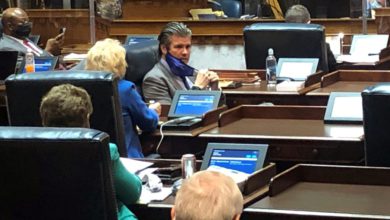
- Over 1,200 firefighters continued to battle the Tamarack Fire near Lake Tahoe in California and Nevada.
- in Oregon, the nation’s largest wildfire, the Bootleg Fire, grew to 624 square miles Thursday – just over half the size of Rhode Island.
- Almost 80 large wildfires are now burning across the U.S., including 19 in Montana.
A large wildfire in Northern California spread into Nevada late Wednesday, leading to new evacuations, while crews battling the nation's largest fire in Oregon were aided by better weather.
Smoke from wildfires in the West continued to spread Thursday, bringing hazy skies and poor air quality to many locations.
More than 1,200 firefighters battled the Tamarack Fire near Lake Tahoe in California and Nevada on Thursday. The fire has burned more than 68 square miles of national forest.
A request for evacuations was issued for portions of Douglas County, Nevada, as the fire spread across the state line. An evacuation center was set up at a community center in Gardnerville, Nevada.
Fire officials expected active or extreme fire behavior Thursday, which could see 14-mph winds and temperatures approaching 90 degrees.
To the northwest, the Dixie Fire spread up the west flank of the Sierra Nevada, expanding to more than 162 square miles. The west shore of a resort lake and many other small communities were under evacuation orders.
In Oregon, the nation’s largest wildfire, the Bootleg Fire, grew to 624 square miles Thursday – more than half the size of Rhode Island.

Authorities said lower winds and temperatures allowed crews to improve fire lines in that blaze. The fire approached an area burned by a previous fire on its active southeastern flank, raising hopes that lack of fuel could reduce its spread.
More than 2,200 people are fighting the fire, which is about one-third contained.
Fire weather:From fire clouds to fire tornadoes, here's how wildfires can create their own weather
California fires:PG&E plans to bury 10,000 miles of power lines in California wildfire prevention effort
Almost 80 large wildfires are burning across the USA, including 19 in Montana. More than 200 fires are burning in Manitoba and Ontario, according to Canadian officials.
More than 21,700 wildland firefighters and support personnel are assigned to wildfires, the National Interagency Fire Center said.
The forecast was not as hopeful in other parts of the country: The National Weather Service said Thursday that "elevated to critical fire weather extends from the northern Sierra Nevada to northwest Montana, where wildfires are expected to be most likely to spread uncontrollably."
Smoke and other particulate matter from fires in the western USA and Canada traveled downwind, producing hazy skies and reducing air quality – in some cases thousands of miles from the points of origin, according to the U.S. Drought Monitor.
After a cold front swept the skies clean in the Northeast overnight, smoke was forecast to be thickest across the Carolinas, the Ohio and Tennessee Valleys, the Great Lakes and the Upper Midwest on Thursday, the weather service said. Air quality alerts were issued from Minnesota to North Carolina.
In North Carolina, the weather service warned "air quality is expected to reach code orange, which is unhealthy for sensitive groups and means individuals with respiratory and/or heart ailments, older adults, and children should reduce prolonged or heavy outdoor exertion."
Research points to potential long-term health damage from breathing in microscopic particles of smoke, meaning millions of people could be at risk far from where huge fires burn.
Contributing: The Associated Press
Source link










